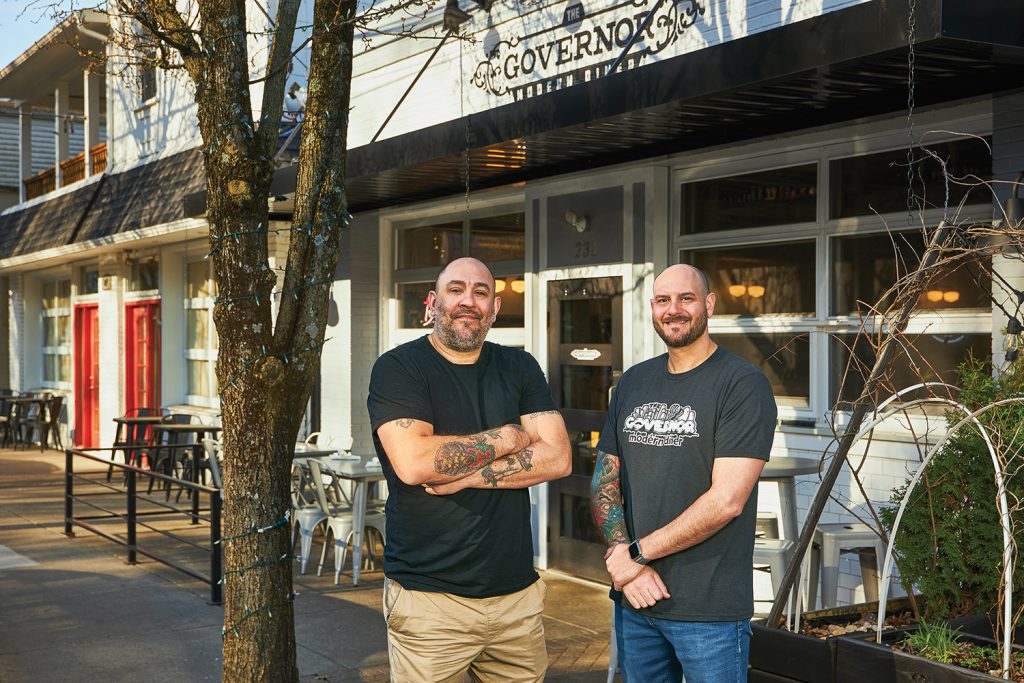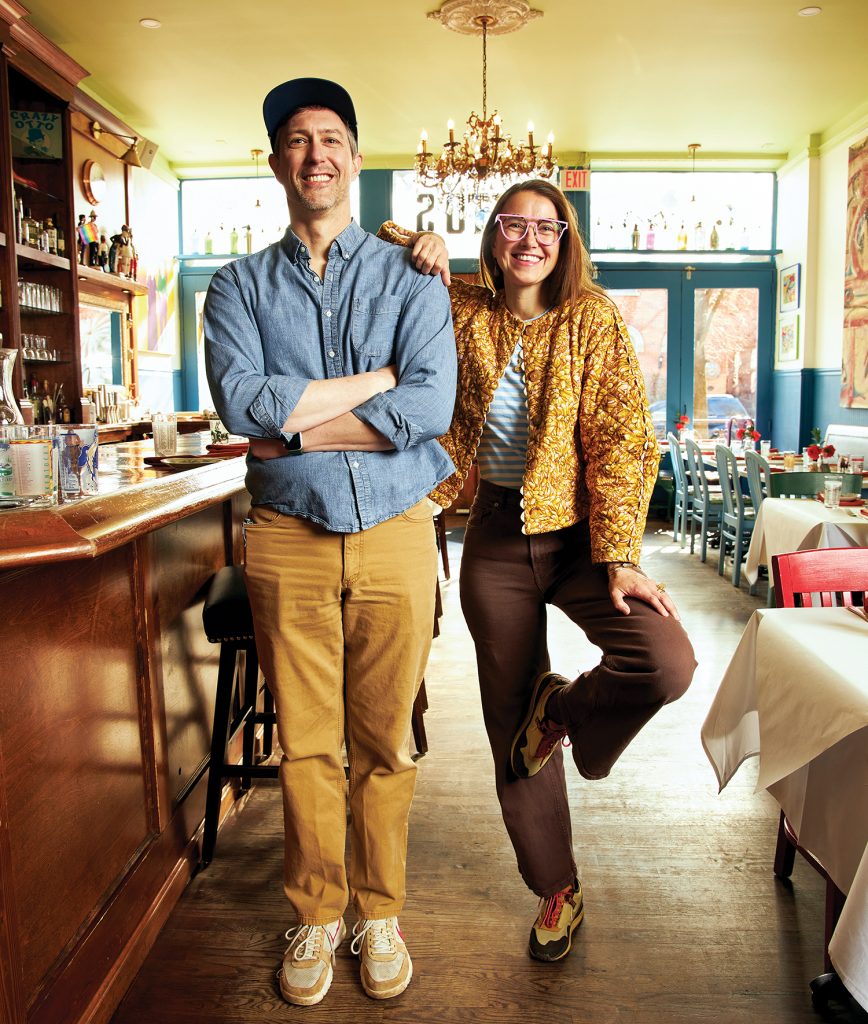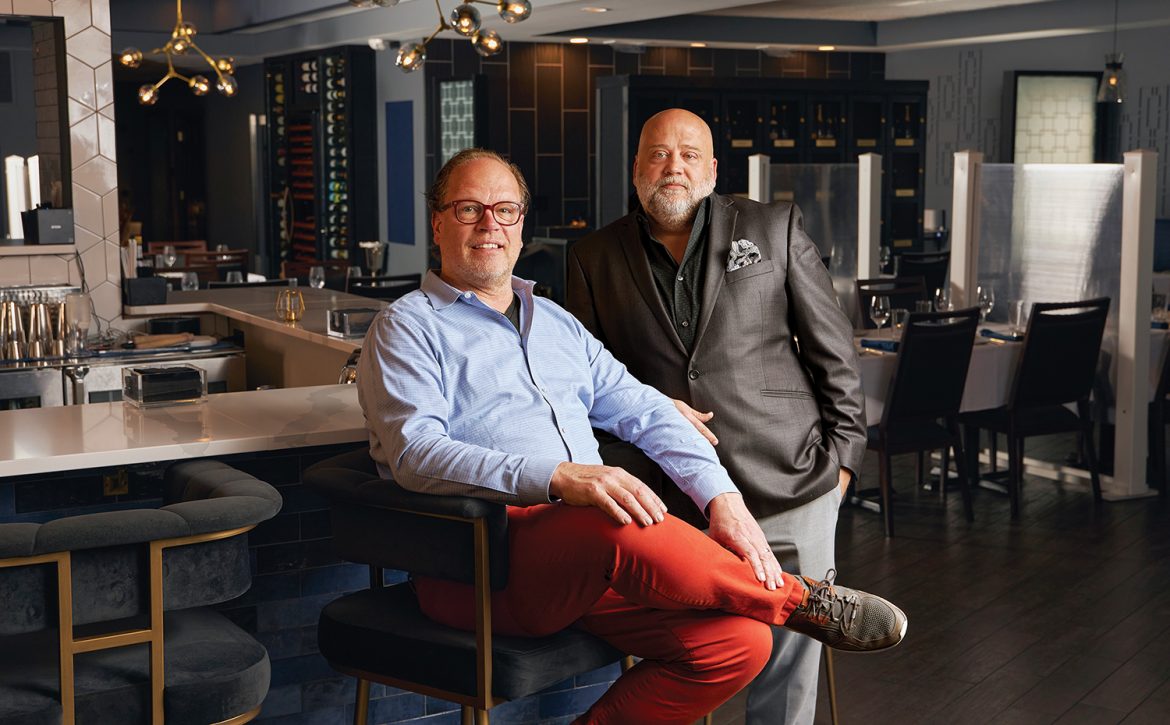She slapped another stream of fresh paint on the tired wall. Her back hurt, and she felt a pop in her ribs—a reminder that her twins were due in just a few weeks. But Emily Wolff and her husband, Paul Weckman, had fully embraced the chaos in their lives back in 2003. Just out of college with their first- and second-born on the way, they were converting a shuttered deli into what would become a critical piece in the revitalization of Covington’s MainStrasse neighborhood: Otto’s.
“This was like our third child,” Weckman recalls as he munches on a plate of green fried tomatoes. “We were all in. We had the mindset that we were going to live here, raise our kids here, work here, and volunteer here to help make a community. That’s what it takes to succeed.”
Brothers Paul and Neil Barraco opened their dream eatery, The Governor, in downtown Milford just five weeks before COVID shut down the world. The classic diner with a modern twist wasn’t the first restaurant to grace this charming Main Street, but the long lines for Saturday and Sunday brunch tell you a table there is now the place to see and be seen.
“Truthfully, it was the community that kept us going through COVID,” says Paul Barraco, pointing to a window that served as the restaurant’s take-out portal. “We had to lay off 90 percent of our staff, but our customers came up to the window for their lunch and dinner, and, even though we had no seating for a year, we didn’t lose any money.”
Frank Eversole acknowledges that when he and his partner, Rick Pouliat (pictured above), decided to open Ivory House in Westwood there were probably a few eyebrows raised around town. A fine dining establishment with white tablecloths, a sophisticated wine list, authentic Japanese Wagyu A5 steak, and triple-digit priced entrees on the west side? The duo had no doubts. They didn’t want just another casual dining experience—they wanted to create a destination.
“Sometimes we can be our own worst enemy,” Eversole says with a shake of his head. “We think we’re not good enough. We think it’s too hard, and so it doesn’t happen. We said, No, we are good enough and it’s going to work because this community will support it.”
A restaurant is a neighborhood’s front porch, a place where friends meet for lunch, business deals are sealed, and family traditions are born and nurtured. It’s often where teenagers earn their first paycheck, where a forlorn street can spring to life with new activity, and where friends and family members can realize the dream of business ownership.
And, if a restaurant is successful for even a short period of time, it can inject a neighborhood with the sort of identity and energy few other businesses are able to do.

Perhaps no single industry suffered more from the COVID pandemic than the hospitality sector. Restaurants nationwide saw their business come to a screeching halt on that fateful day we all remember—March 11, 2020—as governors across the country issued emergency orders and restaurant owners laid off staff and scrambled to figure out how to survive.
Over the months America remained shuttered, the National Restaurant Association reported that more than 90,000 eateries—nine out of 10 of them family-owned, slim-margin establishments employing fewer than 50—had gone out of business. That’s roughly 15 percent of the entire industry. Some have come back, the association says, but many continue to suffer and even close in a failed attempt to rebound. Profit margins are small in the restaurant business, and so is the margin of error.
As Americans retreated into their homes or ventured out masked into a muffled world with plenty of parking spots but no place to go, Neil Barraco says, the key to The Governor’s survival was family and friends. “We grew up here in Milford, so we know a lot of people,” he notes, mentioning pre-Governor working stints at nearby Padrino’s and 20 Brix. “When we opened five weeks before COVID hit, it was a madhouse in here. Just jampacked. We were rockin’ and rollin’ because people not only loved the food, they loved the atmosphere.”
Barraco thinks that’s why many customers came back as soon as The Governor was able to shift to a takeout business model with a window onto the sidewalk in effect serving as a portal into what The Governor had been. “The community support was there from the beginning, and when word-of-mouth spread that you could get out and grab a good dinner to take home? That saved us,” he says. A supportive family helped, as well—Mom, Dad, and two of Neil’s kids went to work keeping the orders filled.
It’s not that take-out was invented during the pandemic, but when COVID forced restaurants to completely convert to that model, it did two things. As Barraco notes, it saved those willing to embrace the to-go model to survive. But, perhaps as importantly, it also preserved fragments of a community that grows up organically around restaurants anchoring important retail districts across the region.
“We’re fueled by regulars,” says Barraco. Familiar faces grace the tables and countertops two or three times a week thanks, in part, to Milford’s walkability and a nearby upscale apartment complex. As he speaks, a few customers wander in for an early lunch and are greeted by the bartender by name.
That walkability and The Governor’s popularity help fuel the rest of Main Street commerce. When the restaurant reaches capacity and customers go on a wait list, the staff encourages them to wander the street. Often, Barraco observes, they return with a bag under their arm from boutique retailer LeiMarie Limited or a record album from Spiral Groove.
Westwood is Cincinnati’s largest neighborhood with more than 35,000 residents, known as the home of Madcap Puppets and Westwood Town Hall. But it’s Ivory House and nearby Muse Café, Nation, and West Side Brewing that have introduced a lively after-dark buzz to the community.
While West Side boasts 30 beer taps, Muse offers a sandwich and salad experience, and Nation slings its signature burgers in a renovated firehouse, Ivory House has curated a sophisticated vibe that boosts the redevelopment and rebranding of Westwood’s commercial district. “When Frank and Rick went out on a limb to create a fine dining restaurant that became a destination for people outside Westwood, that was transformative,” says Stephanie Collins, executive director of the community development nonprofit Westwood Works. “It’s not just Ivory House, but WB Grill and Aubrey + Zach’s ice cream shop also bring people together and promote development of the neighborhood.”
Eversole and Pouliat own all three and are planning at least two more restaurants there in the years to come. Eversole agrees that Ivory House in particular has come to the attention of a loyal and affluent set of customers who may never have ventured to Westwood but for the cuisine he offers. “We draw from Montgomery, Indian Hill, Mason, Loveland, and other east side places,” he says. “A lot of it is the cuisine and special service we offer, but some of the loyalty comes because many of our customers from the east side have west side roots and really enjoy the opportunity to come home.”
Eversole and Pouliat are corporate expats who aren’t from Westwood originally but, 20 years ago, fell in love with and saw opportunity in a neighborhood that Eversole described “feeling like a stepchild” back then. Neighborhood pride was evident, he says, but community energy wasn’t. So the two founded a development group, EP Investments, in 2004 and for almost 15 years purchased and restored dozens of the community’s time-worn housing stock. “We drew a circle about a mile out from the Town Hall and said, We’re going to focus on developing market rate housing within that circle,” he says. “We wanted to make a noticeable difference, and we knew people would come if there was affordable housing.”
When Eversole’s employer restructured and he took a buyout, he moved into commercial real estate. EP Investments acquired the former Huntington Bank building south of Harrison and Montana avenues, and Ivory House was born. The building also houses the Gingerbread House daycare center. “These gathering places are important to the life of the neighborhood, but you have to be sure what you’re doing fits the community,” he says. “Great food is important, but you’ve got to be sure people feel welcome and comfortable too.”
Comfort and familiarity, he says, bring people back to Westwood’s Town Hall district, whether they live down the street or on the other side of town. That relaxed lifestyle, he believes, will be the catalyst for continued economic growth.

South of the river, it’s lunchtime on a sunny winter afternoon, and Otto’s is packed. There are tables of silver-haired ladies enjoying salads. A young couple occupies a spot near the kitchen. There’s a fussy toddler who looks like he’d rather explore the kitchen than eat what’s on his plate. Every stool at the bar is filled and, outside on a day that hints the groundhog might have been right after all, the sidewalks are bustling. MainStrasse feels alive.
“This revitalization didn’t happen right away,” Wolff recalls over the din of mealtime conversations. She notes that MainStrasse was a noted bar district as the century dawned and the crowds showing up on a Friday night could be rough and rowdy. When you walked into a MainStrasse restaurant, you weren’t hit with aromas of fine cuisine—you were hit with an eye-watering blast of cigarette smoke. “So here we were, just out of college, and we said, Let’s create a casual dining atmosphere with white tablecloths, art on the walls, and an experience for everyone as soon as they came in the door,” she says, laughing. “We were really a novelty. We had pictures on the wall!”
One more novelty: Weckman and Wolff opened Otto’s as a non-smoking restaurant. In Kentucky. Before it was chic. Before it was the law. And yet people came.
While Wolff is the creative force behind the atmosphere in their Covington restaurant group (which includes Frida’s, The Standard, Mama’s on Main, and Larry’s), Weckman is the food guru and business mind—the former born of a passion for cooking he picked up in college and the latter from his business degree from the University of Kentucky and a short stint at Morgan Stanley. Wolff sees the beauty in an old building with good bones, and Weckman looks for new opportunities to broaden the neighborhood’s appeal.
They’re developers, but not the kind you might think. There’s an innate charm to MainStrasse, Wolff notes, and Weckman echoes that sentiment. New businesses, he says—especially restaurants and other social gathering places—need to reflect that charm. And they can’t be faked.
“It’s got be organic,” he says. “A young chef comes into a cool neighborhood that no one knows about and fixes up an old building, gives it life, and makes the best food. That still works.”
With a pinch of disdain and a dash of dismissiveness, Weckman says he’s skeptical about the formulaic assumptions of some commercial real estate developers that restaurants are a quick fix for any empty building space. “That’s not the kind of soulful development we’re all about,” he says. You only need look a block north of Otto’s to find a ground floor “For Lease” sign where a generic restaurant adjacent to a soulless modern parking garage failed.
“Soulful development” doesn’t sound like anything he learned in business school, and Weckman is OK with that. He says he’s helping to create “a whole community experience” in MainStrasse that will bring in business from all over the region with a variety of cuisines and dining options that appeal to young and old.
Wolff is working to create a community that emulates the German village streetscape the neighborhood is known for. The architecture is key, she says, noting she and Weckman saved the building that now houses Frida’s from the wrecking ball just days before it was scheduled to be demolished. “That would have been like losing our two front teeth,” she says.
Back in Westwood, a building is actually being demolished, and it’s OK. Eversole, whose investment group purchased the old Bolton & Lunsford Funeral Home building in 2021, has decided to invest up to $15 million to replace the 100-year-old Renaissance Revival structure with a modern five-story multi-use building. He sees the site, which is across from Westwood Town Hall, as key to continuing the business district’s momentum. While he would have liked to save the original structure, its design and multiple building styles from different eras made it impractical.
Specific plans for the new building are still on the drawing board, but EP Investments is all-in on two culinary concepts: Paloma (Mexican cuisine) and Terraza Trattoria (Italian). Home for both is likely to be on this site.
In Milford, there is more coming from the Barraco brothers. The entrepreneurial spirit behind these community developers—who reside in their communities and not in boardrooms— isn’t satisfied by success; it’s infectious. Next door, the high pitch of a band saw is barely perceptible through the wall, but come summer the Barrocos will open a Cuban restaurant and cocktail lounge there called Flamingo Drive. Look for live bands, island cocktails, salsa dancing lessons, and maybe the ghost of Ricky Ricardo.
“It’s all a part of keeping downtown Milford alive into the night,” says Paul Barraco. “The DORA district (designated open refreshment area) helps tremendously, and now we’ll keep it going at least until midnight. So we’ll be the early openers on this side and the late closers on the other side.”
In MainStrasse, Weckman and Wolff are focusing on a couple of unique projects. A community garden is being developed on a vacant lot in nearby Goebel Park, where some of the food they’ll serve will be grown. They plan to give employees the option to spend a shift outdoors in the garden rather than waiting tables. It’s a food-to-table concept spanning just a few hundred yards from seed to plate.
“The neighborhood is going to see our workers actually transporting raw produce on carts walking up the sidewalk from the garden and into our restaurants,” Wolff says excitedly. “Just like in Europe.”
The couple, to complement their commercial success, has remained in the residential development business with a focus on small living spaces. The vibe in MainStrasse, says Weckman, is fueled by young creatives who work in the community but need affordable housing. Affordability is key, he says, but so are comfortable, modern units that fit today’s lifestyle. He hopes that young creatives will fuel existing businesses and encourage the establishment of new enterprises.
“When we do home rehabs now, we can do one house with one tenant or we can do micro units and charge a lesser amount to get these cool, hip kids in our community,” says Weckman. “A lot of these young residents are our employees, so we want to take care of them.”
He doesn’t seem to worry about gentrification. His residential small unit strategy includes, in his words, “pricing that’s less aggressive than most developers” and a belief that his more modest income goals will result in MainStrasse retaining its identity. “Look,” he says, “we spend 97 percent of our lives on this block, we’ve raised five kids here, and we live just around the corner. We want it to stay nice.”
Meanwhile, a van full of ladies from a local senior center pulls up to the newest restaurant in Wyoming, Gilligan’s on the Green, Eversole’s latest venture. It’s an American Irish restaurant and pub located in an old firehouse in the Village Green district. The restaurant on this President’s Day afternoon is soon filled with locals from young to old.
“This is why I love neighborhood restaurants,” Eversole says. “I love it when it takes 10 minutes just to get seated because you’re stopping to see everyone who’s there and you’re visiting with them at their tables before finally sitting down with a big smile on your face.”
Unlike Ivory House, Gilligan’s is nestled in a mixed residential and small business neighborhood. Wyoming is a wealthy community with a less defined “downtown” district than Westwood, Milford, or MainStrasse.
Eversole partnered with West Side Brewing’s Joe Mumper on Gilligan’s, and it’s likely St. Patrick’s Day in Wyoming will never be the same again. Eversole has plans to ramp up the energy with live bands and cornhole tournaments on the restaurant’s large patio and lawn. No doubt it’s a boon to Wyoming’s economy. More than 70 people work there, most of them Wyoming residents.
Eversole’s eyes glance down the street to the village of Lockland, which is literally on the other side of the railroad tracks—a town that’s never recovered from its dismemberment decades ago by the construction of I-75. Could Gilligan’s inspire development and better days ahead just a few blocks to the east?
“I think so,” says Eversole. “They have some cool buildings on their strip, many of them not being used at all. I see opportunity. It’s there for somebody to take that first step, but it’s going to require somebody with a passion for the neighborhood.”
Back in Covington, Wolff recalls a rap on the plate glass window while she was painting the walls of what would become Otto’s. Maybe it was curiosity, maybe it was chivalry, maybe it was just wanting, in her words, “to help these crazy kids out,” but the man soon had a paint brush in his hands and happily helped convert the empty storefront into what would become a neighborhood jewel. Others came and have kept coming as loyal customers. Some of their kids have waited on customers or helped in the kitchen.
“We employ a lot of people, we pay taxes, and we promote our community and give it a sense of pride,” Weckman says of economic catalyst restaurants like Otto’s, The Governor, and Ivory House. “You’ll succeed if you keep it unique and make sure you stay connected to your neighborhood.”


